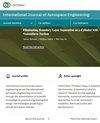Vibration Response Analysis of a Tethered Unmanned Aerial Vehicle System under Transient Wind Field
IF 1.2
4区 工程技术
Q3 ENGINEERING, AEROSPACE
引用次数: 0
Abstract
The transient wind is one of the dangerous conditions encountered by tethered UAVs operating at the ocean, making the cable and the UAV generate complex nonlinear vibration responses threatening normal operation, even safe flight. There is a lack of research on the nonlinear vibration of the tethered UAV in a transient wind field environment. This study analyzes the vibration response of a tethered quadrotor UAV under a transient wind field, which helps to boost the tethered UAV applications, providing engineering suggestions to design these systems. Considering both cable and UAV motions, the coupled dynamic equations of the tethered UAV system are established based on the Hamilton principle. The variation law of the cable vibration amplitudes with wind field and position is analyzed through a one-minus-cosine gust profile to describe the transient wind field, which can evaluate the dynamic behavior of systems in the actual flight. Moreover, the positions of maximum vibration amplitude in tangential and normal directions are found to be approximately 9/10 and 9/20 from the lower end of the cable. Furthermore, the tethered UAV system vibrations are investigated under different structural parameters. The results indicate that the UAV can maintain a stable single-period motion by increasing the length or elastic modulus or selecting the appropriate diameters of the cable. Finally, an experiment is implemented on the vibration response of the tethered UAV system in a wind tunnel. The theoretical result is compatible with the experimental one, demonstrating the theoretical method’s accuracy.系留式无人飞行器系统在瞬态风场下的振动响应分析
瞬态风是系留无人机在海洋上运行时遇到的危险条件之一,会使缆绳和无人机产生复杂的非线性振动响应,威胁到无人机的正常运行,甚至安全飞行。目前还缺乏对瞬态风场环境下系留无人机非线性振动的研究。本研究分析了系留四旋翼无人机在瞬态风场下的振动响应,有助于促进系留无人机的应用,为这些系统的设计提供工程建议。考虑到缆索和无人机的运动,基于汉密尔顿原理建立了系留无人机系统的耦合动力学方程。通过描述瞬态风场的一减余弦阵风剖面,分析了缆索振幅随风场和位置的变化规律,从而评估了系统在实际飞行中的动态行为。此外,还发现切线方向和法线方向的最大振动振幅位置距缆绳下端分别约为 9/10 和 9/20。此外,还研究了不同结构参数下的系留无人机系统振动。结果表明,通过增加缆绳的长度、弹性模量或选择适当的直径,无人机可以保持稳定的单周期运动。最后,在风洞中对系留无人机系统的振动响应进行了实验。理论结果与实验结果一致,证明了理论方法的准确性。
本文章由计算机程序翻译,如有差异,请以英文原文为准。
求助全文
约1分钟内获得全文
求助全文
来源期刊

International Journal of Aerospace Engineering
ENGINEERING, AEROSPACE-
CiteScore
2.70
自引率
7.10%
发文量
195
审稿时长
22 weeks
期刊介绍:
International Journal of Aerospace Engineering aims to serve the international aerospace engineering community through dissemination of scientific knowledge on practical engineering and design methodologies pertaining to aircraft and space vehicles.
Original unpublished manuscripts are solicited on all areas of aerospace engineering including but not limited to:
-Mechanics of materials and structures-
Aerodynamics and fluid mechanics-
Dynamics and control-
Aeroacoustics-
Aeroelasticity-
Propulsion and combustion-
Avionics and systems-
Flight simulation and mechanics-
Unmanned air vehicles (UAVs).
Review articles on any of the above topics are also welcome.
 求助内容:
求助内容: 应助结果提醒方式:
应助结果提醒方式:


